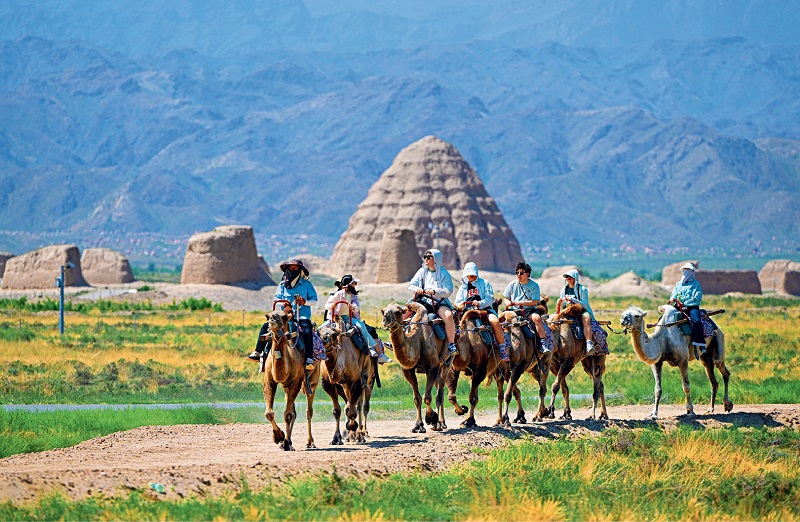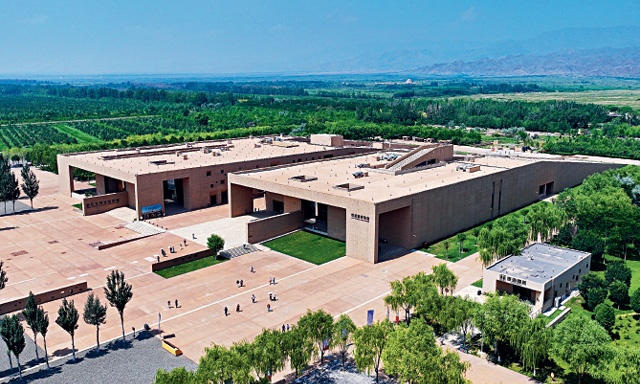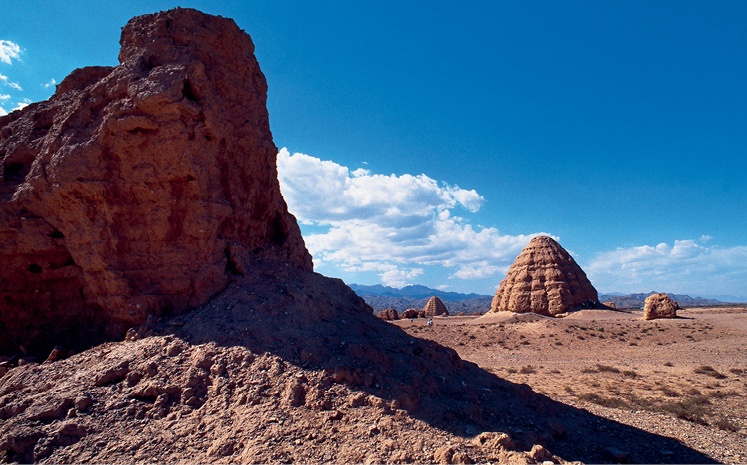On July 11, 2025, the imperial tombs of the Xixia Dynasty (1038-1227) were formally inscribed on the UNESCO World Heritage List, bringing the number of China’s treasures that are recognized with this prestigious honor to 60.
The tumuli clusters at the foot of the Helan Mountains, also known as the “Oriental Pyramids,” are now officially part of humanity’s common heritage and present another doorway to the world through which to learn more about the Chinese civilization.

Locals and foreign tourists ride camels during a tour of the Xixia Mausoleums scenic area in Yinchuan City, Ningxia Hui Autonomous Region on July 13, 2025.
Deciphering the Royal Code
In 1937, German aviator Wulf Diether Graf zu Castell soared over the Helan Mountains in northwest China’s Ningxia when clusters of white earthen mounds below caught his attention. He pressed his camera shutter, immortalizing the scene in his book China Flug, and confusingly captioned the photograph as “termite mounds” or “prehistoric ruins.”
Thirty-five years later, in June 1972, researchers in Ningxia discovered a fragmented stele inscribed with unintelligible scripts in the Gobi desert. When archaeologists identified these scripts as the long-lost Tangut script – missing for centuries – a royal necropolis that had remained hidden for nearly eight centuries was finally exposed.
Over the ensuing half century, fieldwork and archaeological excavations were carried out at the Xixia Imperial Tombs. As documented on China’s National Cultural Heritage Administration website, since the initial survey began in 1971, excavations have been conducted non-stop, gradually clarifying the necropolis’ spatial layout. In the 21st century, thorough clearance of ground-level remnants at Tombs 3 and 6 has further unveiled the site’s distinctive sociocultural fabric.
As the largest, highest-ranking, and best-preserved archaeological complex surviving from the Xixia, or Western Xia, Dynasty, the necropolis of 40 square kilometers encompasses nine imperial tombs, 271 subsidiary burials, one northern architectural complex, and 32 remnants of flood control infrastructure. The monumental tombs, together with 7,100 exquisite artifacts unearthed, bring to life a vivid panorama of Tangut civilization. As a distinctive branch of ancient Chinese civilization, Tangut culture remains quintessentially unique. According to Wang Changfeng, deputy director of the mausoleum administration, “The earliest historical documentation of these imperial tombs appears in the section “Chronicles of the Xia State” in the History of Song, yet their precise locations were never specified.”
“The necropolis serves as the master key to deciphering Tangut society,” said Wang. “Its nine imperial mausoleums and 271 subsidiary burials form China’s most intact complex of rammed-earth royal tombs, a microcosmic representation of the Xixia Dynasty’s sociopolitical structure.”
Yang Rui, chief expert at the Research Base for the Chinese Nation Community of North Minzu University, contended that the mausoleums represent the most important testament to the vanished Xixia civilization. The ruins and artifacts show distinctive features of the Xixia Dynasty in social institutions, religious beliefs, funerary customs, and cultural and technical practices. They embody centuries of exchange between the Tangut civilization and other ethnic groups, showing the diverse, yet integrated, nature of the Chinese nation.
The gilded bronze ox and luminous green-glazed Chiwen (a mythical beast) reveal the masterful craftsmanship shared by Xixia and Central Plains civilizations. Fragmented steles inscribed with Tangut and Han scripts offer glimpses into cultural interchange between the Song and Xixia dynasties. In addition, architectural elements such as sutra pillars testify to Buddhist beliefs, while funerary artifacts like coins, silk, and beads are evidence of Xixia’s connection with the Silk Road.
“This constitutes the very vitality of the open, inclusive Chinese nation,” said Chen Tongbin, honorary director of the Architectural History Institute at China Architecture Design & Research Group and leader of the Xixia Imperial Mausoleums’ World Heritage bidding team. “The necropolis holds an irreplaceable place in Asian and global history.”

Locals and foreign tourists visit the Xixia Imperial Mausoleums scenic area in Yinchuan City, Ningxia Hui Autonomous Region on July 13, 2025.
Technology-Powered Conservation
When the images of nine colossal mausoleums were projected onto the screen at the 47th session of UNESCO’s World Heritage Committee in Paris on July 11 this year, the world witnessed not merely a cluster of tombs, but the resonance of a vanished dynasty. The mausoleums’ 14-year journey to World Heritage inscription has finally brought success.
The World Heritage Committee highly commended the Chinese government for its immense efforts in the conservation of these mausoleums. It recognized that the legal framework involved, the conservation management mechanisms, and the scientific research in the earthen sites conservation have provided robust safeguards for preserving the authenticity and integrity of this heritage.
Rao Quan, vice minister of culture and tourism and head of the National Cultural Heritage Administration, emphasized that the Chinese government will continue to fulfill its obligations under the World Heritage Convention to ensure the broad dissemination and perpetual legacy of the mausoleums. China will further strengthen holistic and systematic conservation of cultural and natural heritage, and stands ready to share its expertise with all other nations, providing professional and technical support to jointly safeguard humanity’s shared cultural treasure.
The Institute of Oriental Manuscripts of the Russian Academy of Sciences, the world’s largest repository of Xixia documents, has collaborated with China since the 1980s. Irina Popova, director of the institute, has visited the Xixia mausoleums multiple times over the past 21 years. She once expressed deep admiration for China’s effort in cultural heritage conservation.
In the 1990s, the Management Office of the Xixia Mausoleums in Yinchuan initiated collaboration with the Dunhuang Academy – a pioneer in conserving earthen sites in arid regions. At the conservation site, experts from the Dunhuang Academy confronted challenges specific to rammed-earth ruins in arid and semi-arid environments. Researcher Yang Shanlong led a team to develop techniques including fissure sealing and multi-layer surface consolidation. After two decades of field application, these methods have successfully stabilized the structure of the ruins.
“We have implemented over 60 structural reinforcement projects at the Xixia mausoleums, mitigating risks of structural instability and surface erosion,” said Yang Shanlong. “These techniques have also been applied in the conservation of the Great Wall. They are globally relevant when it comes to earthen heritage preservation in arid regions.”
Patrol and maintenance of the mausoleum complex are equally crucial. According to Wang Changfeng, a monitoring system is now operational, covering video surveillance, intrusion alerts, and real-time tracking of temperature, humidity, and other environmental metrics. During rainy seasons, data analytics predict moisture absorption in rammed earth structures, allowing timely adjustments to conservation methods.
“While technology empowers us, conservation philosophy is also evolving,” said Wang. “We now replicate damaged components with 3D printing, digitally reconstruct the mausoleums’ original appearance through virtual reality, and even cultivate ‘biocrusts’ – microbial communities that stabilize rammed earth surfaces.” As a result, visitors use AR glasses to time-travel to the Xixia era, while students engage in interactive puzzles to reassemble pottery fragments.
Preventive conservation is also underway. Structural reinforcement of all nine imperial mausoleums and 44 subsidiary tombs has been completed. Integrated flood control, security, and fire-prevention systems are fully functional, alongside a digital repository housing 200,000 artifact records. A state-of-the-art monitoring center tracks real-time changes across four dimensions: heritage structures, natural environments, managerial operations, and visitor flows.
Yet new challenges persist. Can microbial biotechnology inhibit salt-alkali erosion? How can visitor access be balanced with site preservation? “Safeguarding world heritage is an endless journey,” said Wang.

The Xixia Imperial Mausoleums serve as a key in understanding the Xixia society. Their hierarchically structured layout acts as a miniature model of the Xixia Dynasty. Yu Xiangjun
 A Window into Chinese Civilization
A Window into Chinese CivilizationThe inscription of the Xixia Mausoleums on the World Heritage List not only signifies international recognition of China’s unique imperial tomb complex, but also affirms the historical legacy of multiethnic exchange and integration embodied by the Xixia civilization.
“The funerary architecture system integrates the Han culture of the Central Plains, Buddhist traditions, and the distinctive customs of the Tangut people, showcasing the formative process of the Chinese civilization as a diverse and integrated entity,” said Romain Lefebvre, a French scholar of Xixia studies.
While its World Heritage designation enriches the diversity of global cultural heritage, it is only the beginning. Today, consensus has been reached across central authorities, local governments, the private sector, scholars, and tourism practitioners to transform the site into a vivid showcase of the defining attributes of Chinese civilization.
Professor Du Jianlu, dean of the School of Ethnic Studies and History at Ningxia University, is finalizing the publication of the monumental tome Comprehensive History of Xixia, while preparing the biennial International Symposium on Xixia Studies. This year, the symposium will spotlight “The Cultural Values of the Xixia Mausoleums” as its central theme, aiming to forge global academic consensus on the site’s significance.
Since its opening to tourists in 1986, the mausoleums have ranked among northwest China’s most iconic cultural destinations. Today, within the Xixia Mausoleums Museum, innovative technologies are transforming visitor experiences.
Smart display cases and 3D scanning technology allow touchscreen access to artifacts’ casting techniques and history; and through real-time audio interpretation systems, the meaning of ancient texts are deciphered. Visitors are suggested to explore the museum before approaching the ruins for deeper insights.
The museum now attracts more younger people for research-based education. Designated a National Research and Practice Education Base for Primary and Secondary School Students, it offers over 30 specialized courses. Each summer, students sketch amidst the ruins and appreciate museum collections.
During the summer of 2025, after a downpour, the Helan Mountains were shrouded in mist. Rainwater flowing through nine-century-old drainage canals – a testament to ancient engineering ingenuity – flowed steadily downward, as if the arteries of Chinese civilization endure unbroken.